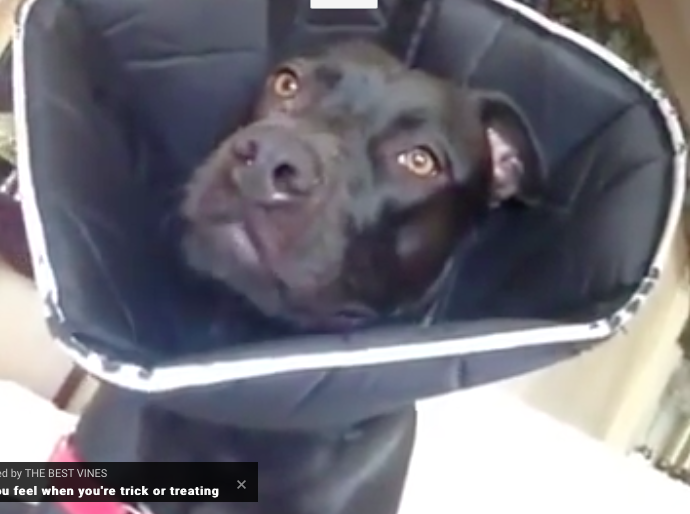Watch this dog’s priceless reaction to finding out there’s a cone on his head.

On a serious note, dog owners often need to put cones on their dog’s heads to protect a healing surgical incision or wound from their pup’s prying paws and tongue. Unfortunately, your pooch may view that cone as more of a hindrance than a help and without praise and encouragement he might not become comfortable wearing it. Here are a few tips to help you along.
The Fit
For your pup to be as comfortable as he can be wearing a clumsy hard plastic cone on his head, measure his neck and head to properly size it. If that cone is too tight or too loose, he’ll be very unhappy in it and it might even irritate his skin or come off of his head. Most veterinary offices have cones in stock, so consult with your vet about sizing in case you aren’t quite sure which one works best for your pup, especially if he’s between sizes.
Preparation
When you slip that hard, satellite dish-like cone over your pup’s head, he’ll likely become upset by the feeling of it on his neck and how it impairs his vision and movement. If possible, prepare your pooch for wearing the collar prior to a scheduled surgery. Introduce it to him slowly, praising him and rewarding him with treats each time he inspects it and eventually wears the collar for short periods of time. Eventually he’ll associate that “cone of shame” with yummy treats and positive attention.
Making Adjustments
The Elizabethan collar can seriously impair your pooch’s movements and you can expect that he’ll be bumping into furniture and your legs on a regular basis. Move your furniture around to accommodate the size of the cone. Elevate your pup’s food dishes to make it easier for him to reach his food. Groom your pup’s face for him so that he feels clean, and if possible, completely bathe and groom him before his surgery. Try not to remove the collar during the entire time he needs to wear it.
Safety
For the duration that your pup has to wear his cone collar, supervise him outdoors so that he doesn’t get hurt and trip or fall due to his lack of visibility and impaired mobility. You also don’t want to sneak up on your pup when his vision and movements are impaired. Make some noise before approaching him and come into his field of vision before touching him.
Collars are not to “shame” pets or annoy owners, they are essential for quicker and better healing of a surgical site or injury. Next time your vet recommends an E collar or a similar device, please follow their advice. It truly is in your pet’s best interest.

